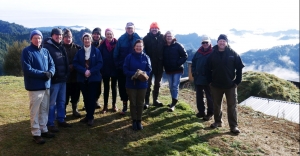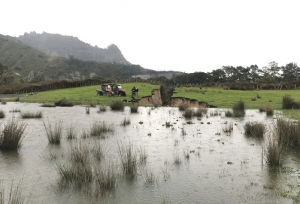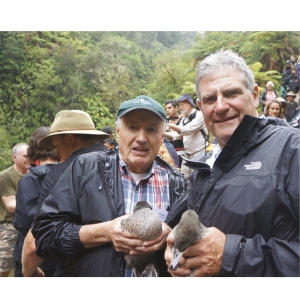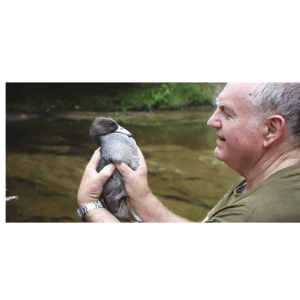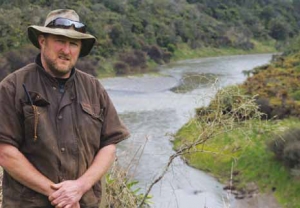Displaying items by tag: Blue Duck Station
Boardroom above the clouds
DU Director Dan Steele hosted a DUNZ Board of Directors meeting at his place – Blue Duck Station on the banks of the Whanganui and Retaruke rivers – over Queen's Birthday Weekend in June.
The visit included the formal board meeting and a tour of the station, including a trip up by ATV to see The Chef's Table, the restaurant that Dan co-owns with acclaimed English chef Jack Cashmore.
The restaurant's hilltop location has spectacular 360-degree views of Tongariro and Whanganui national parks, and though Mt Taranaki was shrouded in cloud on the Saturday morning, Mt Tongariro, Ruapehu and Ngauruhoe more than made up for the no-show.
Other ports of call on the tour of the station included the old homestead perched on the bank of the Whanganu River where Dan's parents live, and, up the Retaruke, the remnants of the ill-fated Berryman bridge, which collapsed in 1994, killing beekeeper Ken Richards.
Dan's colourful warts-and-all commentary on the history and characters of the region was eye-opening and capped off an entertaining and educational weekend.
NEWS IN BRIEF
Where are the swans?
Royal swans are on the wane and DU Director Will Abel wants suggestions about getting hold of some breeding stock. Please contact Will on 06 362 6675.
More Flights scheduled
From next year, Flight magazine will be published three times a year in February, June and October. Submissions of stories, photos, story ideas and suggestions should be emailed to Alison Murray at This email address is being protected from spambots. You need JavaScript enabled to view it..
DU rep appointed
Director Neil Candy has been appointed as a member of the Game Bird Habitat Trust Board, which distributes funding to develop and enhance the wetland
habitats of game birds and other wetland inhabitants. He attends his first meeting as a board member this month in Dunedin where 12 applications for funding will be reviewed.
What's on the telly
DU directors Dan Steele and Jim Law both appeared on TV in August. TVNZ's Matty McLean was given a tour of Blue Duck Station by Dan on the Breakfast show, and Jim and Marilyn Law's Palliser Ridge Station was featured on Country Calendar.
This episode can be watched online at www.tvnz.co.nz/shows/country-
calendar/episodes/s2020-e23 though you may need to sign up first (it's free).
Rainy day reading
New Zealand Geographic has an extensive online feature on wetlands. Go to www.nzgeo.com/stories/wetlands.
Two nights west of the spiral
The winners of a DU auction for a Blue Duck Station experience had a ball. John Dermer reports.
It’s quite a drive! You turn west at Raurimu, famous for its railway spiral, and travel a windy gravel road till you are sure you are lost. When you come to a gate across the road, you’ve arrived.
The station buildings, including the Blue Duck Cafe, sit on a piece of flat land between the confluence of the Retaruki and Whanganui rivers. Our host, Dan Steele, has bought nearby farms as they had buildings on them
for the burgeoning staff that his tourism business needed.
The lovely old homestead that his parents, (“the olds”) live in is at the end of the road and has magnificent views up and down the Whanganui. The garden has some very old trees – oak, beech plus many fruit trees.
Kees and Kay Weytmans and Diny and I had arrived for our two-day stay. We had bought this at the DUNZ auction last winter and as we had had such a good time on Brian and Wendy Simmons' boat the previous summer, we thought we would try Dan’s Blue Duck Station experience this time.
We stayed in a sunny three-bedroom, three en suite lodge with communal kitchen, large dining table plus masses of outdoor seating. The rooms were fitted with quirky handles, hooks and knobs. Unfortunately we forgot to bring a gun to shoot the rabbits!
Dan and Sandy farm Blue Duck Station and neighbouring Retaruki Station, which they lease from his parents.
The total area is 7000 acres (2800 hectares) carrying 5000 ewes and replacements.
It’s mostly steep country – steep to overhanging for much of it, with bush and manuka scrub covering a lot of it. There is some easier country on it but I have to confess that I have been thoroughly spoilt running a small nearly flat farm for a long time now (actually 46 years). Dan, you can keep your hills!
The gorges are deeply incised with sheer papa sides, often showing evidence of a catastrophic rainstorm which lashed the area about two years ago. Not much use for stock water but great for whio.
Dan showed us around in a well-used side-by-side. The tracks are pretty good and he is a mine of information about the area, its history and the people who have lived here.
The station is right beside the Whanganui River, rich in Māori history and the major highway for many years.
One of the houseboats, floating hotels of the time, finished its days moored in the Retaruki just below Dan's parents' homestead.
We saw a beautiful stand of kahikatea (white pine), with other species, rimu, miro, matai and pukatea, growing as well. Dan told us about the well-appointed cave that someone had stumbled on in a sheer face nearby.
Mohawk Joe was growing pot on a well tended area nearby and living in the cave. The police just laughed when they saw it. Dan still says hello to Mohawk when he sees him.
The best story was from wife Sandy. She had only visited Blue Duck a couple of times but wrote in a visitor’s book that she was coming back soon. To marry Dan! Dan loves this country. He has just bought a block of 750 acres with about a third of it grazable. The rest is in native bush and scrub.
Not a block that was going to make him much money from farming but Dan had spotted a knob with a view of the mountains, Ruapehu, Ngāuruhoe, Tongariro.
This was reasonably accessible by ATV and he has a very good chef, Jack Cashmore, who happens to be a carpenter as well.
Hence they had the bright idea to build a high-class restaurant and three chalets up there. The plan is to have top-class fine dining and for people to enjoy a backcountry experience.
Typically, Dan has gone half-shares with the chef in the venture. They hope to finish the complex by September. Give Dan a call as it will be fabulous. I hope this venture goes well for them.
Dan’s business is now heavily slanted towards tourism. (We hardly heard a New Zealand accent the whole time we were there [pre-lockdown]).
He employs 12 people, many involved in tourism, so he was not a “happy chappy” to get the news about Covid-19.
This shut down the tourism side virtually overnight so he is now dependent on his farming and mānuka honey production, with carbon farming from the mānuka and some plantations which have been planted.
One very rough looking block had been planted in redwoods (Sequoia sempervirens) on advice from Horizons.
(I wonder how they will perform on this site.) Another block is in radiata so carbon farming should help through this rough patch.
The map in the Blue Duck Cafe showing Dan’s trap lines is very impressive. He has predator traps all over the place.
More than a thousand of them.
He is great man for doing deals with people who stay there. Free accommodation if you do a few days' rebaiting traps.
Not a great job when you have to remove a very smelly hedgehog. Rats are the main capture at the moment but Dan reckons he will never get rid of them.
We did see a pair of whio, happily sitting on rocks in the river, so all the effort he is putting into his predator control is obviously working.
A jet boat ride down the Whanganui was a highlight. The river is very low so Dan had to keep a sharp eye out for shallow rapids. Also for the many kayakers travelling downstream.
For those of you thinking the gray duck is on the way out, you should see the number on the Whanganui. They are plentiful.
I noticed the same thing many years ago in my own jet boating days, so the numbers seem to be hanging in there.
You win some, you lose some
In 2012 a wetland was created at DU Director Dan Steele’s property, Blue Duck Station in the Ruapehu district, but things haven’t gone exactly as planned. Water has tunnelled under the pumice layer – the hills are predominantly pumice – to the next hard layer, first creating an underground leak, which DU’s John and Gail Cheyne noticed during a visit.
Next came the washout: Dan says, “We first noticed pumice floating down the Retaruke River before we found the washout.”
As of publication date, the problem is still waiting for a solution.
Meantime Dan has not been idle but had to climb out of his gumboots for a day or two to head to the city, see The biggest conservation project on Earth.
DU directors in the news
DU directors in the news – for good reasons
Two DU directors, John Dermer and Dan Steele made the news this year,
both appearing in mainly rural papers, and both for very good reasons.
Dan Steele - Conservation and tourism with farming
John Dermer – the ultimate Farm Forrester
Dan (the Blue Duck man) Steele
Ducks Unlimited director Dan Steele, is one of this year’s five Nuffield New Zealand Scholarship winners.
- Bede O’Connor, a West Coast dairy farmer.
- Ben Allomes, Woodville dairy farmer.
- Satwant Singh who is part of the Fonterra Commodity Risk and Trading team and also works on her family dairy farm near Morrinsville.
- And finally Sharon Morrell a regional leader with Dairy NZ based in Rotorua.
Restoring the balance for whio
Horizons Regional Councillors joined DOC representatives and iwi at Blue Duck Station in February 2017 for a whio release, during a tour of the northern parts of the ManawatuWhanganui Region. Blue Duck Station set within the Kia Wharite project, has seen Horizons, DOC, Whanganui iwi and
private landowners working in the private lands and remote forests around Whanganui National Park to improve land, water and biodiversity, while enhancing community and economic wellbeing. Kia Wharite is one of the largest projects of its kind in New Zealand in scale and scope.
Back in February, way before the weather bomb hit Blue Duck Station, (see page 7) Horizons Regional Councillors joined the Department of Conservation (DOC) deputy director general operations, Mike Slater, and iwi representatives for the release of 14 whio at Blue Duck Station.
The whio release was a hands-on opportunity to show how Kia Wharite, a collaborative biodiversity project in the Whanganui/ Ruapehu districts, is directly contributing to the survival of native species.
Since 2008, Horizons, DOC, Whanganui iwi and private landowners have been working in the private lands and remote forests around Whanganui National Park to improve land, water and biodiversity health, while enhancing community and economic wellbeing. Kia Wharite is one of the largest projects of its kind in New Zealand in terms of scale and scope.
The Kia Wharite project spans over 180,000 hectares and includes a mixture of private land and parts of the Whanganui National Park, the second largest lowland forest in the North Island. This remote area is home to the largest population of Western North Island brown kiwi and plays host to many native bird and plant species.
Possums, goats, stoats and other predators have threatened the health of the forest and put the long-term future of its inhabitants in jeopardy.
Horizons Councillor Bruce Rollinson said as part of the project extensive possum control operations have been undertaken by Horizons and OSPRI on rated land, and DOC on crown land. OSPRI have signalled a phased withdrawal from areas inside the project sites, as these areas are declared TB free. Currently approximately 150,000 hectares of land has regular possum control undertaken in the project area.
This work, alongside pest and weed control, protecting bush and wetlands and monitoring threatened native species, is also why it was possible to release 14 whio into the Kaiwhakauka Stream. Here, whio are protected on the river through a network of traps managed by Blue Duck Station volunteers to target stoats, said Cr Rollinson.
Predator control is carried out in the wider whio security site by Horizons and DOC; over 85 km of trap lines are in place along the Retaruke and Manganui o te Ao rivers, providing necessary protection for whio.
Department of Conservation deputy director general operations Mike Slater said with a population of fewer than 3000, this national whio security site is one of eight locations identified across the country as being essential for whio recovery.
With the support of Genesis Energy, DOC has been able to double the number of fully secure whio breeding sites, boost pest control efforts and enhance productivity and survival of these rare native ducks. The ultimate goal of this security site is to achieve protection to 50 breeding pairs, said Mr Slater.
Whio are adapted to live on fast-flowing rivers so finding them means you have also found clean, fast-flowing water with a good supply of insects. This makes whio important indicators of ecosystem health, they only exist where there is high quality, clean and healthy waterways.
It is not just whio and the environment that benefit from the project. Horizons and DOC believe there are positive economic returns to be had from the project. Blue Duck Station is the most obvious example.
The sheep and beef cattle farm, located 55km south-west of Taumarunui, is set on 2915 hectares of medium to steep hill countryDuck Station owner and manager Dan Steele said grazing areas have been deliberately offset by native bush and manuka. “Through the Kia Wharite project, we have
worked closely with Horizons and DOC to develop a sustainable land plan, and fence ofselected farm areas to protect native fauna and flora,” said Dan Steele.
“The Station has approximately 450 traps for stoats, mustelids, feral cats, rats, mice and hedgehogs; all enemies of the blue duck as well as other native species. In partnership with Kia Wharite, we maintain and reset the traps approximately every two weeks; this is undertaken mainly by our olunteers or ecowarriors as we call them.
“Embracing the environment in this way provided the perfect place to set up a lodge and tourism operation. In a relatively short time we have grown to approximately 8000 visitors a year, many of whom become ecowarriors during their stay,” said Dan Steele.
Cr Rollinson said Kia Wharite is proving to be a successful approach, with the project already exceeding some of its goals. “It shows what can be accomplished when organisations join forces and work collaboratively.”
Fears for Whio
Fears for whio after weather bomb
February (2017) brought a highlight on the conservation calendar at Blue Duck Station – the release of 14 rare juvenile blue ducks (whio) into the Kaiwhakauka Stream.
After months of preparation in which the young whio were raised in captivity and prepared for life in the wild on an artificial stream, teams from Blue Duck Station, the Department of Conservation (DoC), Horizons, and Whio Forever saw the ducks off into their new home as part of a community event at Blue Duck Falls. A representative from the local iwi blessed the ducks before volunteers released them into the Kaiwhakauka, watching as they swam upstream into their new habitat. The long term aim is for the ducks to form breeding pairs along the length of the Kaiwhakauka stream, further strengthening the local whio population.
Unfortunately, the joy was short lived. In March a weather bomb wreaked havoc along the Kaiwhakauka. Over 100ml of rain fell in one day, causing flash floods and land slips that battered the Station. The environment around the Kaiwhakauka changed drastically – fallen trees and boulders littered the river, while flooding risked washing away the newly released whio. High water levels also threatened the whio’s ability to feed in the stream and with the stream bed turned upside down, it is unclear how much feed is left for the ducks.
While the damage is severe, the team at Blue Duck Station remain optimistic. In the coming months they will be assessing the impact and planning how best to help the ecosystem recover. Sightings of juveniles have continued in the surrounding areas since the floods, so hopes are high that habitats can be restored for further releases in the future and that Blue Duck Station will continue to be a haven for whio.
Maxine Ross, David Atkinson.
Out there for the Long Haul
written by Lou Sanson, Director General, DOC).

